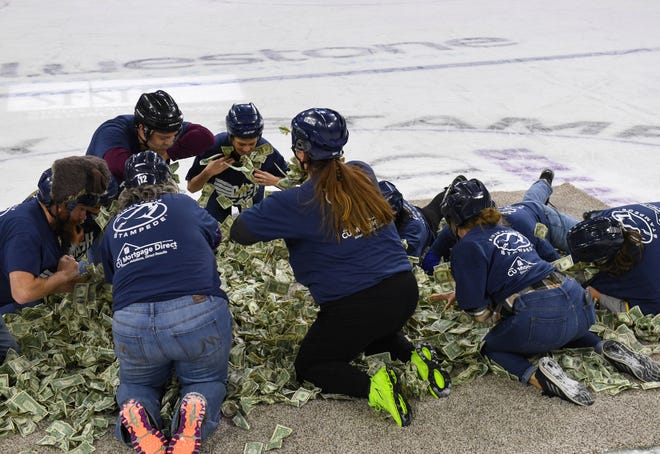“Dash for Cash” emphasizes the issue of educational funding
Photo provided by Argus Leader/Erin Woodiel
Ten teachers crawl on the ground scavenging for $1 bills, proving the ongoing educational funding issue.
December 23, 2021
Educational funding and teacher salary in South Dakota is ranked second to last in the nation. The Stampede, unintentionally, but prominently, was the gasoline in the already burning fire by creating the “Dash for Cash” game. Its results, more negative national publicity for South Dakota to add to the existing poor treatment of educators.
The “Dash for Cash” game was held during an intermission between the periods of a Stampede hockey game on Dec. 11, 2021. The halftime “entertainment” was hosted by CU Mortgage Direct. The game consisted of 5,000 $1 bills scattered across a mat in the middle of the rink in the Stampede stadium. The 10 contestants, chosen from a pool of 31 teachers, wore t-shirts and hockey helmets in preparation for the game. The educators quite literally “dashed” across the mat to collect as many dollar bills as possible, stuffing them inside of their shirts and pants while scooping as many as they could into their arms as spectators watched from the sidelines above. So, why was this “fun” halftime activity so problematic?
In South Dakota, funding for education and teacher salary is ranked 49th, which is already a bad look. The “Dash for Cash” had the intention to give teachers the opportunity to receive money for supplies and other necessities for their classroom, only in a publicly degrading manner. Not only was this a crude representation of the education system, but it also put the issue on a higher pedestal as South Dakota gained more negative attention for the previously existing funding issue. LHS teacher Roxy Harte emphasizes the bad effects that the “Dash for Cash” had on South Dakota and more specifically, the school districts.
“However, making national and international news for this event didn’t help our community image, our profession, or our community partners who do support education and educators,” said Harte.
Although the intentions for the event were most likely positive, the results did not solve any of the funding issues, nor were they an encouragement to the chosen educators, but instead a degrading blow aimed toward teachers and the education system in itself. Teachers often use their own source of income to improve their classroom and make it a more welcoming environment for their students, or to simply provide what is needed for students to learn in the best way possible, as Harte says.
“While I’m sure organizers of the Dash for Cash thought this was a fun way to help a few teachers, a systemic change and cultural change is needed where teachers are not expected or feel pressure to spend their own money to meet classroom needs/wants,” said Harte.
Instead of having means to solve the ongoing funding issue, the “Dash for Cash” emphasized the larger issue at hand. The underfunding and low salary of teachers, the ones who are raising up the next generation, has become more obvious because of events like this. South Dakota State Representative Erin Healy considers the lack of funding affair and how the “Dash for Cash” was a step in the wrong direction when concentrating to solve these issues.
“It really just shows how truly broken our system is,” Healy said. “Events like this aren’t going to really solve our funding problem.”
In consideration of the lack of funding received by the education industry and the effects of the “Dash for Cash,” it is important to recognize how we can make strides to improve the broken educational system instead of taking steps in the wrong direction.









